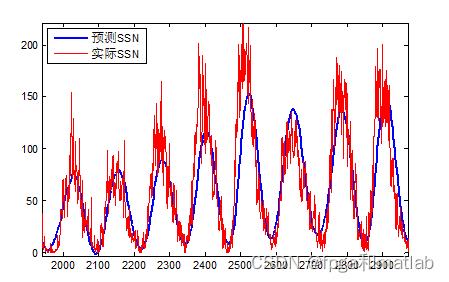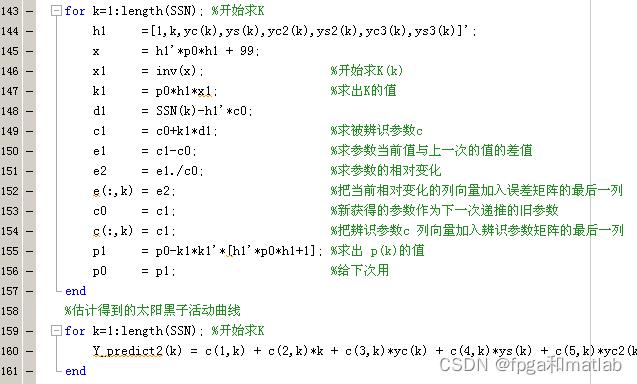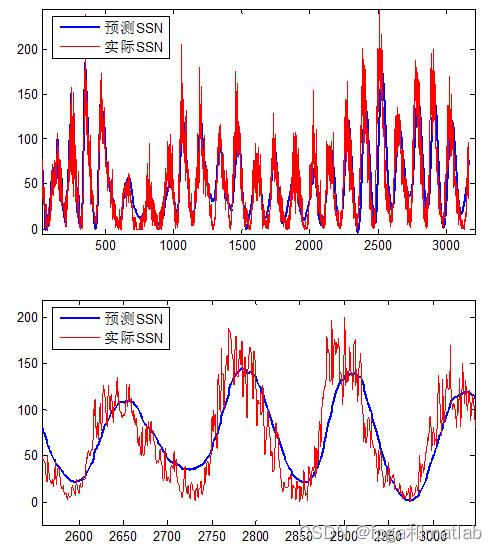太阳黑子预测太阳黑子变化规律预测matlab仿真
Posted fpga和matlab
tags:
篇首语:本文由小常识网(cha138.com)小编为大家整理,主要介绍了太阳黑子预测太阳黑子变化规律预测matlab仿真相关的知识,希望对你有一定的参考价值。
1.软件版本
matlab2013b
2.本算法理论知识
太阳黑子是人们最早发现也是人们最熟悉的一种太阳表面活动。因为太阳内部磁场发生变化,太阳黑子的数量并不是固定的,它会随着时间的变化而上下波动,每隔一定时间会达到一个最高点,这段时间就被称之为一个太阳黑子周期。太阳黑子的活动呈现周期性变化是由施瓦贝首次发现的。沃尔夫 (R.Wolfer)继而推算出11年的周期规律。实际上,太阳黑子的活动不仅呈11年的周期变化,还有海耳在研究太阳黑子磁场分布时发现的22年周期;格莱斯堡等人发现的80年周期以及蒙德极小期等。由于太阳黑子的活动规律极其复杂,时至今日科学家们仍在努力研究其内在的规律和特性。事实上,对太阳黑子活动规律的研究不仅具有理论意义,而且具有直接的应用需求。太阳黑子的活动呈现周期性变化的,沃尔夫(R.Wolfer)根据在过去的288 年(1700年~1987 年)间每年太阳黑子出现的数量和大小的观测数据推算出11 年的周期规律。我们利用Matlab强大的数据处理与仿真功能,对Wolfer数进行功率谱密度分析从而可以得到对太阳黑子活动周期的结论。
使用的线性模型为

这个部分的MATLAB代码为:



现象模型的预测结构如下:

将上面的图放大之后,得到的局部估计效果如下图所示:

然后通过多变量的最小二乘法进行模型预测。引入多个变量作为参数估计,这里,将最小二乘法的估计函数为:

由于从历年的数据可知,虽然总体上数据呈现出周期波形,但是对于每个周期中的波形,其中的局部图中会出现部分高频周期量,所以在估计的时候,这里加上更高频率的分量。使用和上面所讲的最小二乘法进行上述参数的估计。

这个步骤,得到的仿真结果如下图所示:

3.部分源码
clc;
clear;
close all;
warning off;
load Sunspot.txt
%YEAR MON SSN DEV
%画出导入的活动数据
YEAR = Sunspot(:,1);
MON = Sunspot(:,2);
SSN = Sunspot(:,3); %sun spot number
DEV = Sunspot(:,4); %标准偏差表
figure;
subplot(211);plot(SSN,'b.');
title('SSN');
subplot(212);plot(DEV,'b.');
title('DEV');
addpath 'funcs\\'
%step1:Devise and/or employ methods to ?nd the best frequency for the sunspot cycle.
%step1:Devise and/or employ methods to ?nd the best frequency for the sunspot cycle.
%step1:Devise and/or employ methods to ?nd the best frequency for the sunspot cycle.
%找到一种较好的方法计算周期
K = 20;%前22年数据去除
Start = 12*K+1;
mainPeriod = func_cycle_cal(SSN(Start:end));
mainPeriod
%Step2:Predict the time of the next solar maximum and minimum.
%Step2:Predict the time of the next solar maximum and minimum.
%Step2:Predict the time of the next solar maximum and minimum.
%构建预测模型,预测后面的最大值和最小值对应的时间
%构建预测模型,预测后面的最大值和最小值对应的时间
c0 = [1 1 1 1 1 1 1 1]';%直接给出被辨识参数的初始值,即一个充分小的实向量
p0 = 10^6*eye(8,8); %直接给出初始状态P0,即一个充分大的实数单位矩阵
t = 1/(12):1/(12):length(SSN)/(12);
yc = cos(2*pi*t/mainPeriod);
ys = sin(2*pi*t/mainPeriod);
yc2 = cos(2*pi*t/(2*mainPeriod));
ys2 = sin(2*pi*t/(2*mainPeriod));
yc3 = cos(2*pi*t/(3*mainPeriod));
ys3 = sin(2*pi*t/(3*mainPeriod));
for k=1:length(SSN); %开始求K
h1 =[1,k,yc(k),ys(k),yc2(k),ys2(k),yc3(k),ys3(k)]';
x = h1'*p0*h1 + 99;
x1 = inv(x); %开始求K(k)
k1 = p0*h1*x1; %求出K的值
d1 = SSN(k)-h1'*c0;
c1 = c0+k1*d1; %求被辨识参数c
e1 = c1-c0; %求参数当前值与上一次的值的差值
e2 = e1./c0; %求参数的相对变化
e(:,k) = e2; %把当前相对变化的列向量加入误差矩阵的最后一列
c0 = c1; %新获得的参数作为下一次递推的旧参数
c(:,k) = c1; %把辨识参数c 列向量加入辨识参数矩阵的最后一列
p1 = p0-k1*k1'*[h1'*p0*h1+1]; %求出 p(k)的值
p0 = p1; %给下次用
end
%估计得到的太阳黑子活动曲线
for k=1:length(SSN); %开始求K
Y_predict2(k) = c(1,k) + c(2,k)*k + c(3,k)*yc(k) + c(4,k)*ys(k) + c(5,k)*yc2(k) + c(6,k)*ys2(k) + c(7,k)*yc3(k) + c(8,k)*ys3(k);
end
figure;
plot(Y_predict2,'b','LineWidth',2);hold on;
plot(SSN,'r');hold off;
legend('预测SSN','实际SSN');
Predict_Len = 100;%定义预测时间长度
t = 1/(12):1/(12):(length(SSN)+Predict_Len)/(12);
yc = cos(2*pi*t/mainPeriod);
ys = sin(2*pi*t/mainPeriod);
yc2 = cos(2*pi*t/(2*mainPeriod));
ys2 = sin(2*pi*t/(2*mainPeriod));
yc3 = cos(2*pi*t/(3*mainPeriod));
ys3 = sin(2*pi*t/(3*mainPeriod));
ind = 0;
for k=1:length(SSN)+Predict_Len; %开始求K
if k <= length(SSN)
Y_predict3(k) = c(1,k) + c(2,k)*k + c(3,k)*yc(k) + c(4,k)*ys(k) + c(5,k)*yc2(k) + c(6,k)*ys2(k) + c(7,k)*yc3(k) + c(8,k)*ys3(k);
else
%Y_predict3(k) = c(1,end) + c(2,end)*k + c(3,end)*yc(k) + c(4,end)*ys(k) + c(5,end)*yc2(k) + c(6,end)*ys2(k) + c(7,end)*yc3(k) + c(8,end)*ys3(k);
c0 = mean(c(1,end:end));
c1 = mean(c(2,end:end));
c2 = mean(c(3,end:end));
c3 = mean(c(4,end:end));
c4 = mean(c(5,end:end));
c5 = mean(c(6,end:end));
c6 = mean(c(7,end:end));
c7 = mean(c(8,end:end));
Y_predict3(k) = c0 + c1*k + c2*yc(k) + c3*ys(k) + c4*yc2(k) + c5*ys2(k) + c6*yc3(k) + c7*ys3(k);
ind = ind + 1;
Ys(ind) = Y_predict3(k);
end
end
figure;
plot(Y_predict3,'b','LineWidth',2);hold on;
plot(SSN,'r');hold off;
legend('预测SSN','实际SSN');
grid on;
%根据预测结果得到下次太阳黑子活动高峰和低峰的时间
%前一次高峰日期为
XX = 59;
[Vmax1,Imax1] = max(Ys);
[Vmax2,Imax2] = max(SSN(length(SSN)-XX:length(SSN)));%3100~3160
if Vmax1 > Vmax2
II = Imax1;
MM = Vmax1;
time = (length(SSN) + II-3019);%原数据的最后一个月份+预测后的最大值 - 前一个高峰日期
else
II = Imax2;
MM = Vmax2;
time = (length(SSN) + (XX-II)-3019);%原数据的最后一个月份+预测后的最大值 - 前一个高峰日期
end
Years=time/12;
fprintf('下次高峰期日期为:%d',round(2000 + Years));
fprintf('年\\n\\n');
fprintf('最大值为:%2.2f\\n\\n\\n\\n',MM);
%计算下一次低谷值
[Vmin,Imin] = min(Ys);
fprintf('下次低峰期日期为:%d',round(2012 + Imin/12));
fprintf('年\\n\\n');
fprintf('最小值为:%2.2f\\n\\n',Vmin);
A16-13
以上是关于太阳黑子预测太阳黑子变化规律预测matlab仿真的主要内容,如果未能解决你的问题,请参考以下文章